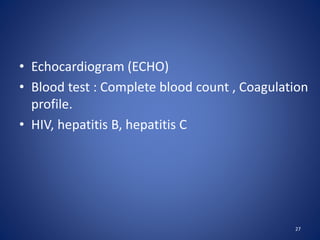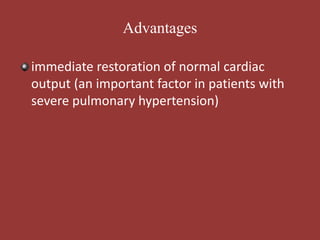Lung transplantation
- 2. Introduction • Lung transplantation involves removal of one or both diseased lungs from a patient and the replacement of the lungs with healthy organs from a donor • May refer to single, double, or even heart-lung transplantation • Accepted modality of treatment for end stage lung disease that is unresponsive to medical therapy 2
- 3. Purpose • To replace a lung that no longer functions with a healthy lung. • To perform a lung transplantation, there should be potential for rehabilitated breathing function. • Other medical treatments should be attempted before transplantation. 3
- 4. History of procedure • First human lung transplantation was done in 1963. Recipient of the lung transplant survived only 18 days. 1983- Dr. Joel Cooper- first successful single lung transplant 1985- Cooper / Patterson- double lung transplant 4
- 5. • Dr. Denton Cooley and associates were the first to attempt heart-lung transplantation in 1968. • First heart-lung transplant in India- 3 May 1999 at Madras Medical Mission. 5
- 6. AGE DISTRIBUTION OF LUNG TRANSPLANT RECIPIENTS 6 0 5 10 15 20 25 18-24 25-29 30-34 35-39 40-44 45-49 50-54 55-59 60-65 66+ Recipient Age %oftransplants J Heart Lung Transplant 2008;27: 937-983
- 7. Indications for lung transplantation • Obstructive lung disease: A. Chronic obstructive pulmonary disease • Restrictive lung diseases: A. Idiopathic pulmonary fibrosis (IPF) B. Interstitial lung disease 7
- 8. Indications for lung transplantation • Septic lung disease: A. Cystic fibrosis (CF) B. Bilateral bronchiectasis • Pulmonary vascular disease: A. Primary pulmonary hypertension (PPH) B. Eisenmenger’s syndrome 8
- 9. ADULT LUNG TRANSPLANTATION: Indications for Single Lung Transplants (Transplants: January 1995 - June 2007) 50% 28% 2% 1%2% 7% 10% Alpha-1 COPD CF IPF PPH Re-TX Other* *Other includes: Sarcoidosis: 2.1% Bronchiectasis: 0.4% Congenital Heart Disease: 0.2% LAM: 0.7% OB (non-ReTx): 0.5% Miscellaneous: 5.8% J Heart Lung Transplant 2008;27: 937-983
- 10. ADULT LUNG TRANSPLANTATION: Indications for Bilateral/Double Lung Transplants (Transplants: January 1995 - June 2007) 24% 14% 18% 8% 28% 6% 2% Alpha-1 COPD CF IPF PPH Re-Tx Other* *Other includes: Sarcoidosis: 3.0% Bronchiectasis: 4.8% Congenital Heart Disease: 1.3% LAM: 1.2% OB (non-ReTx): 1.1% Miscellaneous: 6.6% J Heart Lung Transplant 2008;27: 937-983
- 11. Disease specific selection criteria COPD Patient with BODE index 7 to 10 and at least 1 of the following: 1. FEV1 < 25% predicted ( without reversibility) 2. PaCO2 >55 mm of Hg 3. Elevated pulmonary artery pressure (PAP) 4. Cor pulmonale 11
- 12. Other indices shown to correlate mortality- 1)subjective breathlessness 2)weight loss 3)exercise tolerance 4)hospitalization 5) lung morphology 12
- 13. The BODE Index For COPD Can Fam Physician 2008;54:706-11
- 14. Idiopathic Pulmonary Fibrosis • Highest attrition rate with waiting list mortality 30% • Initially, “refer all patients” • Patients with exercise induced desaturation are ideal candidates 14
- 15. Current consensus- 1) Symptomatic progressive disease despite 3 months of medical therapy 2) Rest or exercise induced desaturation 3) Symptomatic with- VC< 60-70% predicted DLCO < 50-60% predicted 15
- 16. Cystic fibrosis • FEV1 <30% of predicted normal value • PaCO2 >50 mm Hg • Pao2 <50 mm Hg • PAH 16
- 17. Prognostic criteria- 1)age 2)sex 3)FEV1 4)weight for age 5)Pancreatic insufficiency 6)D.M. 7)S.aureus 8)B.cepacia 9)No. of acute exacerberations 17
- 18. Symptomatic progressive disease despite optimal medical treatment for 3 months Cardiac index < 2 lit/min/m2 Right atrial pessure>15 mm Hg PAP mean > 55 mm Hg 18 Primary Pulmonary Hypertension
- 19. Eisenmengers syndrome • Better prognosis than patients with PPH with similar PAP levels • Epoprostenol therapy improved survival & reduced need for transplantation • Heart -lung transplantation is preferred 19
- 20. Sarcoidosis • Most patients benign course • In 10-20% permanent sequel • Which stage ? • FVC < 50% & FEV1 < 40% 20
- 21. Contra-indication (Absolute) • Malignancy in the last 2 years • Non-curable chronic extra pulmonary infection including chronic active hepatitis B , C , and HIV • Untreatable advanced dysfunction of another major organ system • Current cigarette smoking 21
- 22. • Poor nutritional status • Poor rehabilitation potential • Significant psychosocial problems • Substance abuse • History of medical noncompliance • Active Tuberculosis 22
- 23. Relative Contraindications : • Age : advanced age is associated with higher mortality rates • Age cut-off 55 years for -Heart-lung transplantation, 60 years for- Bilateral lung transplantation, 65 years for -Single-lung transplantation. 23
- 24. • Ventilator dependence • A prolonged wait while the patient is on a mechanical ventilator may lead to various complications such as infections, cardiovascular de- conditioning. • Psychosocial issues 24
- 25. • Decreased Body weight • Obesity (BMI >30) • Extra pulmonary organ dysfunction 25
- 26. Laboratory studies : • Arterial blood gases (ABG ) • Pulmonary function tests (PFTs) • Computerized tomography (CT) • Ventilation perfusion scan (lung scan, V/Q scan) • Electrocardiogram (ECG) 26
- 27. • Echocardiogram (ECHO) • Blood test : Complete blood count , Coagulation profile. • HIV, hepatitis B, hepatitis C 27
- 28. Donor-related issues: • Younger than 65 years for lung transplantation and younger than 45 years for heart-lung transplantation • Absence of severe chest trauma or infection • Absence of prolonged cardiac arrest • Minimal pulmonary secretions • Negative screens for HIV, hepatitis C, and hepatitis B 28
- 29. • Blood type (ABO) compatibility • Close match of lung size between donor and recipient • PaO2 > 300 mm Hg on 100% fraction of inspired oxygen • Clear chest radiograph • No history of malignant neoplasms 29
- 30. Surgical techniques • Heart–lung transplantation • Single lung transplantation • Double lung transplantation
- 31. Heart–lung transplantation • Reserved for patients with combined parenchymal and cardiac disease • Is it useful for cor pulmonale? • After excision of the heart and lungs of the donor en bloc, the trachea is anastomosed in the recipient just above the carina • The integrity of the anastomosis is maintained as a result of extensive collateral arterial blood supply to the lower trachea from the coronary arteries.
- 32. Advantages immediate restoration of normal cardiac output (an important factor in patients with severe pulmonary hypertension)
- 33. Disadvantage • Requires cardiopulmonary bypass • Significantly higher risk of perioperative bleeding • Heart can also be involved in chronic rejection • The use of both lungs and heart limits the number of potential recipients who can benefit from the donation • The results are poorer
- 34. Single lung transplant (SLT) • Most common indication (~ 60%) COPD • Other indications : – Pulmonary fibrosis and – Primary or secondary pulmonary hypertension.
- 35. ADULT LUNG TRANSPLANTATION: Indications for Single Lung Transplants (Transplants: January 1995 - June 2007) 50% 28% 2% 1%2% 7% 10% Alpha-1 COPD CF IPF PPH Re-TX Other* *Other includes: Sarcoidosis: 2.1% Bronchiectasis: 0.4% Congenital Heart Disease: 0.2% LAM: 0.7% OB (non-ReTx): 0.5% Miscellaneous: 5.8% J Heart Lung Transplant 2008;27: 937-983
- 36. Single lung transplant (SLT) • For SLT, the native lung with the poorest pulmonary function according to the preoperative quantitative perfusion scan is excised. • Exclude bronchiectasis • The lung is exposed via a posterolateral thoracotomy through the fifth intercostal space.
- 37. Single lung transplantation(SLT) • Advantages – potentially two lung recipients and one cardiac recipient can be treated with organs from one donor. – No cardiopulmonary bypass is needed and so patients up to the age of 65 years are being considered for this form of transplantation. – Perioperative bleeding is limited.
- 38. Double lung transplantation(DLT) • Performed as two sequential lung transplants, one side followed by the other. • Operation of choice for cystic fibrosis and bronchiectasis, and is also now advocated for patients with primary pulmonary hypertension . • No need for cardiopulmonary bypass and the risk of bleeding is less than in HLT.
- 39. ADULT LUNG TRANSPLANTATION: Indications for Bilateral/Double Lung Transplants (Transplants: January 1995 - June 2007) 24% 14% 18% 8% 28% 6% 2% Alpha-1 COPD CF IPF PPH Re-Tx Other* *Other includes: Sarcoidosis: 3.0% Bronchiectasis: 4.8% Congenital Heart Disease: 1.3% LAM: 1.2% OB (non-ReTx): 1.1% Miscellaneous: 6.6% J Heart Lung Transplant 2008;27: 937-983
- 40. Figure 40
- 41. Intraoperative details Bilateral sequential SLT is associated with a lower incidence of bronchial complications than the en- bloc DLT procedure and is technically less difficult to perform than en-bloc DLT. The exposure for bilateral sequential lung transplantation is via bilateral anterolateral thoracotomies through the fourth or fifth intercostal space, connected by a transverse sternotomy, i.e., the "clam-shell" incision.
- 42. Living lobar transplant • Involves bilateral implantation of the lower lobes from 2 blood group–compatible living donors. • Donation of a lobe decreases the donor's lung volume by an average of approximately 15% and is not associated with long- term functional limitation • The need for close matching between the donor and recipient is not necessary
- 43. Lung preservation Reduce the risks of fluid overload and to check for pneumonia prior to death. The donor operation involves cannulation of the pulmonary artery and infusion of either prostacyclin or prostaglandin E2
- 44. Lung preservation Preserved inflated at 4°C total ischaemic time below 4 h. Pretreatment by steroids decreases ischemic lung graft Injury. Explanted organ is inflated, with 100% oxygen
- 45. Pre operative care Medical & psychosocial evaluation. Assessment of patient‘s physical health In preoperative phase the patient is assessed for cardiac output & renal functions . Psychosocial evaluation 45
- 46. Post operative care The patient is observed for excessive bleeding. Monitor vital signs ,ECG ,ABG values ,urine output, O2 level analysis & chest tube drainage. The patient may be started on mechanical ventilation for 24 to 48 hours. 46
- 47. Post operative care Serum electrolytes ,complete blood count, chest radiographs are obtained daily. Fluids are restricted. Lung sounds are auscultated. Severity of peripheral edema is monitored. Pain control is important to allow deep breathing & coughing with chest physiotherapy. 47
- 48. Post operative care The patient with lung transplantation is at high risk to develop infection Isolation Monitor the patient for clinical manifestation of infection 48
- 49. Complications 49 Causes of respiratory failure Early ischemia reperfusion injury infection technical problems acute rejection >3months Infections BOS Curr.opin.Crit.care 2006 Feb;12, 19-24
- 50. Ischemia reperfusion injury 50 Most frequent cause of early mortality presents as ALI / ARDS noncardiogenic pulmonary edema related to effect of free oxygen radicals and cytokines
- 51. Post lung transplantation chest radiograph Chest radiograph performed 24 hours following right unilateral lung transplantation - within normal limits.
- 52. Ischemia reperfusion injury Seventy-two hours following lung transplantation
- 53. Ischaemia reperfusion injury 53 Treatment- A) diuretics B) maximal ventilatory support Newer modalities A) inhaled nitric oxide B) inhaled prostacyclin Course- resolves in 48-72 hrs
- 54. Complications 54 Causes of respiratory failure Early ischemia reperfusion injury infection technical problems acute rejection >3months Infections BOS Curr.opin.Crit.care 2006 Feb;12, 19-24
- 55. Infections 55 Bacterial A) pseudomonas B) nocardia C) legionella , mycobacteria (rare) Routine antibiotic prophylaxis reduced the incidence Sputum cultures & antibiotic sensitivity done every 3 months
- 56. Viral infections 56 CMV predominates within 30-100 days after transplant occurs as reactivation or primary infection (donor) routine prophylaxis replaced by close monitoring Treatment-gancyclovir 5mg/kg for 2-3 weeks
- 57. 57 HSV&VZV can cause pnuemonia Acyclovir prophylaxis effective in patients not on gancyclovir EBV related post-transplant lymphoproliferative disease Recently Rituximab ( anti CD20 Ab) found effective
- 58. Fungal infections 58 Aspergillus most common 1) ulcerative tracheitis 2) bronchitis 3) pneumonitis 4) disseminated disease 5) ABPA I.V. or aerolised amphotericin-B used for prophylaxis
- 59. Other rarer organisms 59 Histoplasma Sedosporium Pnuemocystis jirovecii
- 60. Complications 60 Causes of respiratory failure Early ischemia reperfusion injury infection technical problems acute rejection >3months Infections BOS Curr.opin.Crit.care 2006 Feb;12, 19-24
- 61. Rejection 61 Acute rejection- < 7 days onset low grade fever, dyspnoea CXR- 1) Clear 2) illdefined infiltrates 3) pleural effusion reduced FEV1
- 62. Acute rejection 62 TBLB - gold standard in diagnosis Treatment- bolus I.V. steroids + increase in maintenance immunosuppression role of surveillance bronchoscopy to detect rejection early is controversial
- 63. Acute lung rejection Characterized by perivascular mononuclear cell infiltrates with extension into the adjacent alveolar septa
- 64. Acute and resolving lung rejection (A) Chest radiograph illustrates bilateral infiltrates characteristic of acute pulmonary rejection. (B) Follow-up radiograph after pulsed methylprednisolone treatment of acute rejection demonstrating resolution of infiltrates
- 65. Complications 65 Causes of respiratory failure Early ischemia reperfusion injury infection technical problems acute rejection >3months Infections BOS Curr.opin.Crit.care 2006 Feb;12, 19-24
- 66. Chronic rejection 66 Bronchiolitis Oblitrans Syndrome (BOA) : Predominantly a small airway disease occurs in 50% patients surviving for 5 years onset > 6months major cause of mortality CXR- can be normal, late cases- bronchiectesis HRCT- mottled appearance with peripheral lucency
- 67. 67 TBLB- gold standard Role of induced sputum & BAL- 1) Induced sputum – RANTES levels and eosinophils correlate with BOS development 2) BAL- IL8 & neutrophil levels have negative correlation
- 69. Chronic airway rejection Bronchiolitis obliterans: characterized by luminal narrowing or replacement by dense eosinophilic collagenous scar tissue. Inflammatory cells may be seen in this case
- 70. 70 Treatment- variable course even without treatment various immunosuppressive regimens tried macrolides under evaluation
- 71. 71 Factors associated- 1) CMV pnuemonitis 2) HLA mismatch 3) GERD
- 72. Immunosuppressive therapy Majority receive a triple-drug maintenance regimen calcineurin inhibitor (either cyclosporine or tacrolimus), cell-cycle inhibitor (either mycophenolate mofetil or azathioprine) steroids.
- 73. Immunosuppression The first-line treatment of an episode of acute rejection is high-dose intravenous steroid pulses. For recurrent acute rejection, the strategy is to switch from cyclosporine to tacrolimus. 73
- 74. Post-op. Management Antimicrobial therapy • Bacterial prophylaxis • HSV prophylaxis → Acyclovir • PCP → Cotrimoxazole • Candida → Nystatin • CMV -- Ganciclovir
- 75. Prognosis • Mortality rate is higher for patients with primary pulmonary hypertension, idiopathic pulmonary fibrosis, or sarcoidosis and lower for those with COPD or α1-antitrypsin deficiency. • Mortality risk factors include cytomegalovirus mismatching, human leukocyte antigen mismatching, diabetes, and prior need for mechanical ventilation or inotropic support.
- 76. 76 • Exercise capacity has been the most interesting functional outcome observes in lung transplant recipient . • Typically transplant recipient can walk 100 to 120m/min within 6 months of transplantation.
- 77. LUNG TRANSPLANT IN INDIA Ist lung transplantation : 3 may 1999 (HLT) in Madras Medical Mission ,by Dr K M Cherian Pt expired after 36 days 1st SLT : 11 July 2012 @ Hinduja hospital , Mumbai for IPF by Dr Jnanesh Thacker .
- 78. LUNG TRANSPLANT IN INDIA List of approved hospital in India for lung transplantation Frontier Life Line, R-30-C Amabattur Industrial Estate, Chennai . Chettinad Hospital and Research Institute, Kelambakkam, Kancheepuram District ,Tamilnadu Apollo Hospitals Enterprises Ltd., Chennai PSG Super Specialty Hospital, Peelamedu, Coimbatore Global Hospitals and Health City, No/439 Cheran Nagar, Perumbakkam, Chennai 600 100
- 79. 79 Cost of Lung Transplantation in India • Surgery alone cost Rs 10 lakh. • The ICU and medications will work up to an equal amount
- 80. Question Ist successful single lung transplant was done by 1. James hardy 2. Cooper 3. Demikhov 4. Peterson
- 81. Question Ist successful single lung transplant was done by 1. James hardy 2. Cooper 3. Demikhov 4. Peterson
- 82. Question Most common indication of bilateral lung transplant a. COPD b. Pulmonary fibrosis c. Cystic fibrosis d. Pulmonary hypertention
- 83. Question Most common indication of bilateral lung transplant a. COPD b. Pulmonary fibrosis c. Cystic fibrosis d. Pulmonary hypertention
- 84. ADULT LUNG TRANSPLANTATION: Indications for Bilateral/Double Lung Transplants (Transplants: January 1995 - June 2010) 26% 16% 17% 7% 27% 5% 2% Alpha-1 COPD CF IPF IPAH Re-Tx Other* *Other includes: Pulmonary Fibrosis, Other: 2.9% Sarcoidosis: 3.0% Bronchiectasis: 4.4% Congenital Heart Disease: 1.2% LAM: 1.1% Connective Tissue Disease: 1.3% OB (non-ReTx): 1.3% Miscellaneous: 1.7% ISHLT 2011ISHLT J Heart Lung Transplant. 2011 Oct; 30 (10): 1071-1132
- 85. Question Earliest test to detect early graft failure 1. CxR 2. Spirometry 3. ABG 4. CT-thorax
- 86. Question Earliest test to detect early graft failure 1. CxR 2. Spirometry 3. ABG 4. CT-thorax
- 87. 87























































































